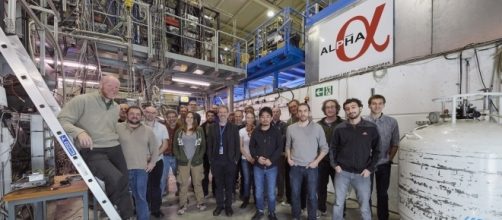As reported in Nature today, CERN’s Alpha experiment has made a major breakthrough in the ability to study Antimatter. Up until now astrophysicists and experimental physicists had never been able to observe a spectral signature for any antimatter, making it expensive and difficult to look for it in the universe and in experiments. The U.S. effectively gave away the leadership in nuclear physics research when Congress defunded the Texas supercollider.
What CERN did
The accomplishment of the scientists in the Alpha experiment was to produce enough anti-hydrogen and keep it long enough to be able to observe the emission spectrum pattern it produced when heated with a LASER.
“Using a laser to observe a transition in antihydrogen and comparing it to hydrogen to see if they obey the same laws of physics has always been a key goal of antimatter research,” said Jeffrey Hangst, Spokesperson of the ALPHA collaboration.
Spectra
Although scientists and alchemists knew that different elements gave off different colours when burned, It wasn’t until the 1800’s that chemists and physicists were able to begin using the spectrums produced to identify various elements.
In fact "spectrum" wasn’t even a word until Sir. Isaac Newton coined it in his book "Opticks" [sic.].
The spectrum of light is simply a rainbow but when a particular element is burned the light it gives off is in very specific, very narrow bands of light.
This is actually a result of quantum mechanics when an electron in an atom jumps from one energy level to another and either absorbs a corresponding frequency of light (absorption spectra) or emits it (emission spectra).
Since only specific energy levels are permitted (a quantum leap being the smallest possible change between different energy levels), the exact light (or other electromagnetic frequency) is specific to each element.
Antimatter, what’s the big deal?
Although antimatter sounds like something from science fiction, it is basic science we use every day. Antimatter, the fuel for starships in Star Trek, is the same as regular matter but with the charges reversed. Hence an electron’s antiparticle is a positron, identical in every measurement but with the opposite charge.
The antielectron is termed a positron and we use positrons every day in hospitals - a PET scan is actually a Positron Emission Tomography scan.
A new window into the universe
Being able to observe antimatter by its characteristic spectra as the CERN team has just done makes it far easier and less expensive to experiment with and conduct research into other possible uses for antimatter in everyday life.
One of the most exciting potential uses for this discovery is the ability for astrophysicists to detect antimatter in the universe by the spectra it gives off when heated or when other light passes through a cloud of antihydrogen. That’s how we came to understand the composition of the universe in the first place, by looking at the spectra of matter.
ALPHA
The CERN ALPHA experiment hold antihydrogen in a magnetic bottle. Antimatter is somewhat difficult to store because it annihilates any regular matter it touches resulting in an explosion about 1000 times more powerful by original weight than a nuclear or even hydrogen bomb, both of which only convert about 1-2% of the matter during the explosion. An antimatter explosion would convert 100% of the antimatter to energy.
“Moving and trapping antiprotons or positrons is easy because they are charged particles,” said Hangst. “But when you combine the two you get neutral antihydrogen, which is far more difficult to trap, so we have designed a very special magnetic trap that relies on the fact that antihydrogen is a little bit magnetic.”
The new development was a way to create antihydrogen moving slowly enough to capture - this can produce and store as many as 14 anti-atoms at a time. By shining a LASER light to excite the antihydrogen positron it can be made to move between the 1S and 2S “orbits,” a relatively stable position.

